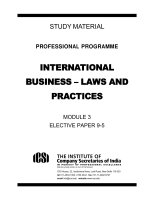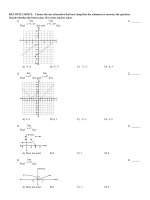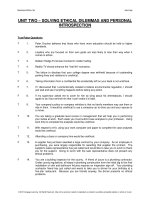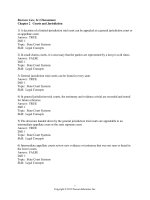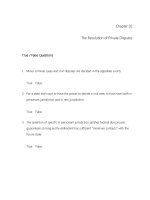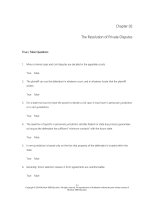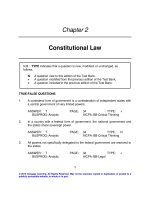International business law and its environment 8th edition schaffer test bank
Bạn đang xem bản rút gọn của tài liệu. Xem và tải ngay bản đầy đủ của tài liệu tại đây (219.3 KB, 8 trang )
Chapter 2
INTERNATIONAL LAW AND THE WORLD’S LEGAL SYSTEMS
TRUE/FALSE
1.
The United States belongs to the Organization for Economic Cooperation and
Development.
ANSWER: True
2.
Pacta sunt servanda means that every treaty in force is binding upon the parties to it and
must be performed by them in good faith.
ANSWER: True
3.
Jus Cogens means preemptory norms of international law.
ANSWER: True
4.
The Vienna Convention codified significant international statutory law.
ANSWER: False
5.
According to the Statute of the International Court of Justice, the court shall look to
conventions establishing rules expressly recognized by the contesting states.
ANSWER: True
6.
The U.N. has recently sponsored a “supranational” set of laws that transcends national
boundaries; most industrialized nations have adopted it.
ANSWER: False
7.
One definition of international law is a rule accepted by the international community of
states.
ANSWER: True
8.
International business law draws from both public and private law as related to business
transactions.
ANSWER: True
9.
Laws applying to private parties in international transactions are called private international
law.
ANSWER: True
10.
The World Court is an agency of the U.S. Government used to settle international disputes.
ANSWER: False
11.
The World Court is a major force in settling world disputes.
ANSWER: False
12.
Only states (nations) can be parties to a case before the World Court.
ANSWER: True
© 2012 Cengage Learning. All Rights Reserved. May not be copied, scanned, or duplicated, in whole or in part, except for use as
permitted in a license distributed with a certain product or service or otherwise on a password-protected website for classroom use.
Chapter 2: International Law and the World’s Legal Systems
13.
The decisions of the World Court are a precedent for all similar actions.
ANSWER: False
14.
A nation can be brought before the World Court whether or not it wants to be there.
ANSWER: False
15.
The enforcement of judgments by the World Court is based on good faith compliance.
ANSWER: True
16.
There is a separate body of law governing all private international law questions.
ANSWER: False
17.
The two classifications of national legal systems are civil law countries and common law
countries.
ANSWER: True
18.
In a common law system, the judge acts as a lawyer in requiring the production of
evidence.
ANSWER: False
19.
All socialist countries have the same legal system.
ANSWER: False
20.
Moral conduct is the preeminent concern in Islamic law.
ANSWER: True
21.
In Islamic law, “gharae” prohibits any gain not clearly outlined at the time of the contract.
ANSWER: True
22.
In the United Nations General Assembly, all nations have an equal vote.
ANSWER: True
23.
The Security Council of the United Nations has veto power over the U.N. General
Assembly.
ANSWER: False
24.
The purpose of the United Nations Commission on International Trade Law is to promote
international trade through the harmonization of trade law among nations.
ANSWER: True
25.
The International Monetary Fund lends money to developing countries to assist them with
such problems as high interest rates and inflated oil prices.
ANSWER: True
26.
Membership in the IMF requires a country to be on the gold standard.
ANSWER: False
27.
The World Bank and IMF are the same organization.
ANSWER: False
28.
The IMF assists member countries that are having balance of payment difficulties.
© 2012 Cengage Learning. All Rights Reserved. May not be copied, scanned, or duplicated, in whole or in part, except for use as
permitted in a license distributed with a certain product or service or otherwise on a password-protected website for classroom use.
Chapter 2: International Law and the World’s Legal Systems
ANSWER: True
29.
The U.S. belongs to the International Trade Organization (ITO).
ANSWER: False
30.
The GATT process has resulted in dramatic reductions in tariffs.
ANSWER: True
31.
The International Chamber of Commerce developed the Uniform Customs and Practice for
Documentary Credit.
ANSWER: True
32.
The International Chamber of Commerce created a forum for the settlement of disputes:
Multinational Arbitration Society (MAS).
ANSWER: False
33.
The International Chamber of Commerce is a liaison with the United Nations to help
advocate views of the private sector.
ANSWER: True
MULTIPLE CHOICE
34.
The multinational conference that met at Bretton Woods, New Hampshire, in 1944 was
instrumental in creating:
A.
The United Nations.
B.
The Berlin Airlift.
C.
The World Bank.
D.
The International Chamber or Commerce.
ANSWER: C
35.
The basic resources of the IMF come from:
A.
Individual taxes levied on each nation's industries.
B.
Quota subscriptions by member nations.
C.
Endowments raised by private contributions.
D.
None of the above.
ANSWER: B
© 2012 Cengage Learning. All Rights Reserved. May not be copied, scanned, or duplicated, in whole or in part, except for use as
permitted in a license distributed with a certain product or service or otherwise on a password-protected website for classroom use.
Chapter 2: International Law and the World’s Legal Systems
36.
GATT stands for:
A.
General Administrative Trade Treaty.
B.
General Assistance for Traffic in Trade.
C.
General Agreement on Tariffs and Trade.
D.
General Administration of Tactical Trade.
ANSWER: C
37.
The purpose of GATT is:
A.
To commit member countries to principles of nondiscrimination and reciprocity
concerning tariff and quota reductions and disputes over these subjects.
B.
To assist member nations in obtaining the relocation of industry to a country.
C.
To force member nations to accept goods from all other member nations.
D.
None of the above.
ANSWER: A
38.
The International Chamber of Commerce is:
A.
Part of the United Nations with emphasis on tariff reductions.
B.
A worldwide organization with business community memberships.
C.
The headquarters for GATT.
D.
None of the above.
ANSWER: B
39.
Public international law involves:
A.
Relationships between public corporations in different countries as to business
terms.
B.
Relationships between nations that are reflected in treaties, conventions, or
charters.
C.
Relationships between private individuals in different countries.
D.
All of the above.
ANSWER: B
40.
The forum for public international law disputes is:
A.
The World Forum.
B.
International Court of Justice.
C.
The League of Nations.
D.
The Hague.
ANSWER: B
41.
A case tried in the World Court can involve which of the following parties:
A.
Nation vs. Nation.
B.
Individual vs. Individual.
C.
Individual vs. Nation.
D.
All of the above.
ANSWER: A
© 2012 Cengage Learning. All Rights Reserved. May not be copied, scanned, or duplicated, in whole or in part, except for use as
permitted in a license distributed with a certain product or service or otherwise on a password-protected website for classroom use.
Chapter 2: International Law and the World’s Legal Systems
42.
Jurisdiction over a case in the World Court is:
A.
Compulsory on all nations.
B.
Unlimited on all nations except communist.
C.
Elective on the part of each nation.
D.
Both A and B.
ANSWER: C
43.
The difference between a common law country and a civil law country is:
A.
Civil law is handled by the government while common law is handled by the people.
B.
A common law country bases its laws on statutes while a civil law country uses
court cases.
C.
A common law country has similar laws throughout its regions while a civil law
country is divided into areas.
D.
A common law country relies heavily on precedent established by previous court
cases while a civil law country uses a comprehensive code of law.
ANSWER: D
44.
In a socialist country, the legal system:
A.
Reflects the private ownership of property.
B.
Is similar to the English common law system.
C.
Exhibits no need for commercial law because such disputes are settled
politically.
D.
None of the above.
ANSWER: C
45.
Islamic law is based on:
A.
Buddha.
B.
Sunnah.
C.
Yoga.
D.
Nirvana.
ANSWER: B
46.
Which of the following is not part of the structure of the United Nations?
A.
General Assembly.
B.
Security Council.
C.
Secretary General.
D.
House of Representatives.
ANSWER: D
47.
In the United Nations, the Secretary General functions as:
A.
The chief administrative officer.
B.
The chairman of the Security Council.
C.
The speaker for the General Assembly.
D.
Both A and C.
ANSWER: A
© 2012 Cengage Learning. All Rights Reserved. May not be copied, scanned, or duplicated, in whole or in part, except for use as
permitted in a license distributed with a certain product or service or otherwise on a password-protected website for classroom use.
Chapter 2: International Law and the World’s Legal Systems
48.
All of the following are purposes of the International Chamber of Commerce except:
A.
Represent business via intergovernmental institutions.
B.
Harmonize international business practices.
C.
Sell shares in international business corporations.
D.
Provide a link with countries with different economic systems.
ANSWER: C
49.
The Organization for Economic Cooperation and Development (OECD) has developed:
A.
Codes of conduct for companies and host countries in an attempt to set ethical
standards for both.
B.
Guidelines for interest rates to be charged multinational enterprises.
C.
Codes of conduct for employee practices for multinational corporations.
D.
None of the above.
ANSWER: A
50.
Doing business internationally requires an understanding of all of the following except:
A.
International law.
B.
National law.
C.
Different international organizations.
D.
Availability of legal counsel in each country
ANSWER: D
51.
The Paquette Habana case concerned:
A.
A question of the applicable method for joining the IMF.
B.
A question discerning applicable international law.
C.
A question concerning the law merchant on mercantile law of Cuba.
D.
A question of which court has jurisdiction over an international case.
ANSWER: B
52.
All of the following are principles established by the codes of conduct promulgated by the
Organization for Economic Cooperation and Development (OECD) except:
A.
To take into account the policies and objectives of the country with which a
corporation operates.
B.
Nondiscrimination in hiring.
C.
Mandatory wage scales for countries in which each corporation operates.
D.
Utilizing “reasonable terms” when transferring technology.
ANSWER: C
© 2012 Cengage Learning. All Rights Reserved. May not be copied, scanned, or duplicated, in whole or in part, except for use as
permitted in a license distributed with a certain product or service or otherwise on a password-protected website for classroom use.
Chapter 2: International Law and the World’s Legal Systems
53.
Foreign investment laws might include:
A.
Protection against state intervention and the ability to repatriate profits.
B.
Repatriation of profits and the ability to have 100% foreign ownership.
C.
Governmental approval of technology transfer agreements.
D.
All of the above.
ANSWER: D
54.
The United States has, in part, accepted the jurisdiction of the International Court of Justice.
The U.S. acceptance does not apply to:
A.
Disputes the parties have entrusted to other tribunals.
B.
Disputes that the United States decided are essentially domestic.
C.
Disputes arising under a multilateral treaty unless all parties affected are before the
court or the U.S. specially agrees to jurisdiction.
D.
A and B only.
E.
All of the above.
ANSWER: E
COMPARATIVE ANALYTICAL QUESTIONS
1.
Under what, if any, circumstances should a foreign defamation judgment be enforced in
the U.S. against a U.S. citizen who has made comments about a foreign citizen over the
Internet?
2.
Is it or is it not appropriate for colleges and universities to enact bans against the
products of U.S. companies using foreign labor?
3.
Weigh the benefits and detriments of the U.S. entering into an ICC treaty.
4.
Discuss the relative strengths of ad hoc tribunals and permanent tribunals.
5.
In what ways is trademark law uniform globally? Different?
6.
What are the similarities among the crimes and issues that beget universal jurisdiction?
How are these uniquely different from all other issues? Are there any parallel issues that
should receive universal jurisdiction?
7.
Compare and contrast the different sources of international law? Which are stronger?
Weaker? More or less justifiable in a global environment?
8.
How are customary law and the general principles of law (international law) similar?
Different?
9.
Compare and contrast public international law with private international law.
10.
Describe the types of foreign judgments that will and will not be enforced in the United
States. Consider the reasons for these differences.
© 2012 Cengage Learning. All Rights Reserved. May not be copied, scanned, or duplicated, in whole or in part, except for use as
permitted in a license distributed with a certain product or service or otherwise on a password-protected website for classroom use.
Chapter 2: International Law and the World’s Legal Systems
11.
Considering the speech protection granted by the U.S. constitution with those of
countries such as Canada, Germany, and the U.K., which are better at furthering a civil
society? A tolerant society?
12.
Assess the value of the UN Security Council as an enforcer of international law.
13.
Compare and contrast the nation, the individual, and the corporation as entities in and
subject to international law.
ESSAY / WRITING ASSIGNMENTS
1.
Draft a treaty that addresses the competing interests (and divergent national speech
laws) where an individual from one country is defamed by a person from another country
over the Internet.
2.
Draft a model code for the enforcement of foreign judgments against U.S citizens where
the underlying foreign law differs from that of the U.S.
3.
Design amendments to an International Criminal Court Treaty to which the U.S. would
likely consent.
4.
Only a limited number of crimes/ issues beget universal jurisdiction. Write a position
paper advocating that another issue/crime should appropriately receive universal
jurisdiction.
© 2012 Cengage Learning. All Rights Reserved. May not be copied, scanned, or duplicated, in whole or in part, except for use as
permitted in a license distributed with a certain product or service or otherwise on a password-protected website for classroom use.
